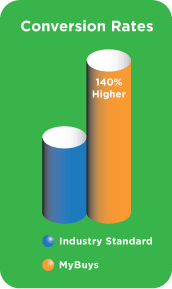A tiny start up called WidgetBucks is claiming they have served over 1 billion ads in the past three months. It is a serious claim, aside the fact they also claim to be the fastest growing ad network on web today.
WidgetBucks features pay-per-click shopping widgets that help their customers make  money fast. They instantly display the most popular products based on buying trends of 100 million shoppers. Thus they are highly engaging, which means instant dollars for our customers. The company is also claiming their widgets see $3-$6 CPM – pretty good compared to traditional ad networks that deliver less than $2 CPM.
money fast. They instantly display the most popular products based on buying trends of 100 million shoppers. Thus they are highly engaging, which means instant dollars for our customers. The company is also claiming their widgets see $3-$6 CPM – pretty good compared to traditional ad networks that deliver less than $2 CPM.
If that’s true and the company had over 1B ads served over the past 3 months and they claim they are seeing $3-$6 CPM (cost per thousand impressions)Â on average it then turns out the company should have its pay outs made over the last months in the $3M-$6M range.
The site offers the following features and benefits.
- Self-service, scalable and relevant content that’s free and easy to publish.
- Dynamic, contextual widgets act as content (vs. ads) that more effectively targets your users, not the masses.
- Extensive reporting tools and daily updates; Payouts are monthly.
- Complements existing programs, such as Google AdSense.
- Over 300 configurations, 256 color schemes and formatted for major IAB standard sizes.
- Dynamic Ad Yield Management matches the best merchant for each product while offering consumers the best price.
- MerchSense (patent pending) contextual algorithm automatically targets the right products for your site.
- Manual configuration also available by category.
- Product listings from 30,000 merchants including trusted leading brands.
Bloggers can customize what kinds of consumer items they want to appear in the widget (books, movies, computers, musical instruments), then they grab some code and put it on their blog. Or they can let Mpire (Widgetbucks’s parent company) serve up contextually relevant ads based on the topics they write about. WidgetBucks scans your site and tries to match ads to the keywords it finds. The widgets tap into merchandise from 30,000 retailers, including Amazon, Shopping.com, Target, Best Buy, Wal-Mart, and the Gap. WidgetBucks shares the cost-per-click revenue with bloggers.
WidgetBucks comes to you from the folks at Mpire Corporation, the award-winning meta-shopping service. Mpire’s extensive shopping data experience, including its proprietary contextual, analytics and relevancy algorithms, power WidgetBucks. Founded in 2005, Mpire is backed by Ignition Partners and former eBay executive and Pay Pal angel investor Richard Rock.
The parent company is a shopping search engine. Not only will it give you a list of links to where to buy that 32-in. LCD TV, if you click on Show Product Details, it will display a pricing chart that shows whether the price is trending up or down, at both retail and at auction, so you can decide if it’s the right time to buy. The “shopping companion” browser plug-in, a free download, is handy to use when you are shopping at other sites; it shows what other etailers are charging for the item you’re looking at, so you can be sure to get the best deal. Soon it will also show how consumers rated the product on Epinions and Amazon. So far this site has indexed more than 150 million products offered by 55,000 online stores, from mom-and-pop Web shops to major e-tailers like Amazon.com, and it doesn’t accept payment from merchants for top placement in its search results.
The site (Mpire) has won a number of prestigious awards from TIME’s 50 Best Websites for 2007 to t the eBay’s winner of the Star Developer Award 2007. WidgetBucks has also won the Mashable Open Web Award.
Others in the sector include Farecast that does the chart thing with airfares, TheFind.com, the old player Epinions and the new comer Proximic, which has just signed a deal with both Yahoo Shopping and eBay’s Shopping.com to contextually deliver their product ads to third party sites. There is also Google’s Gadget Ads (AdSense in a widget), AuctionAds, boobox, and even ThisNext.
Today it seems the company is up to something even bigger – the behavioral widget ads.
While WidgetBucks already had MergeSense to help you determine the best products to display on your site’s widgets, the next step was “to test ad placement within the widget,†says Matt Hulett, CEO of Widgetbucks. The new service is called YieldSense, which is quite close in title to another behavioral ad system called YieldBuild, which determines optimal placement of text ads throughout your website.
YieldSense has some basic behavioral ad techniques being applied to the widget ads. Experts claim widget makers with built in networks have a distinct advantage in the amount of data they’re able to pull, from CPM to attention data, along with the passive absorption of the experiences of ad networks that have come before them.
It seems widget builders and companies are poised to become dominant players in the behavioral ads market due to the nature of the widgets being embedded across number of third party sites gathering that way vast amount of information. WidgetBucks perhaps took that step a little sooner than others because its widget network in fact began as an advertising affiliate program.
Mpire Corporation is based in Seattle, WA.
The behavioral ads market is however not going to be a cake walk for most of the companies. Experts in the sector outline several major issues the industry is facing today. Issues like privacy, accuracy and quality, personalization and profiles are just a few of the behavioral targeting concerns today.
An alternative, being proposed, that solves the issues with both privacy and effectiveness is one centered on understanding the user’s intent, instead of their clickpath or profile, and pairing that with specific content, product, and advertising recommendations. This approach relies exclusively on the collective wisdom of like-minded peers who have demonstrated interests or engagement with similar content and context.
The concept of profiles is completely removed in this case, and instead by understanding the user’s expressed or implied intent that user will see the content that is appropriate to their current mindset.
This is the next evolution in user targeting that gets beyond clicks and analytics, and instead rests on a proven foundation of modern social science theory. The approach is conceptually simple and mimics how we learn and act in everyday life – making choices based on what others who are in the same current mindset as us have done. More about the behavioral targeting can be read over here.Â
The market
Behavioral advertising and behavioral targeting are both lately becoming yet another hot area in the online marketing space, with Tacoda recently acquired by AOL for an estimated amount of $200-300 million. Start ups are trying to analyze every move you do online and try to hook you up with the right ads, products and services. MyBuys is making no exception it tracks user behavior to help online retailers make better recommendations.
Competition in the field is staggering and some of the names include StyleFeeder relying on community recommendations and raised $1M so far, Wunderloop, Baynote, Matchmine, which also raised $10M recently and not last Aggregate Knowledge, which once used to be a hot start-up in the Silicon Valley. The last one that took a massive funding was MyBuys – $10M from Lightspeed Venture Partners and Palomar Ventures.
The demand among online retailers for better behavioral tracking is so high right now that MyBuys and its startup competitors are all able to gather this “low hanging fruit†— Lightspeed Venture Partner’s Peter Nieh explains further.
The market shakeout in behavioral targeting will resemble search engines startup in the 1990’s, Nieh, a Lightspeed Venture Partner, thinks: Many companies were able to search the web, but Google ended up doing it way better than the others, and captured the largest portion of the market.
More
http://www.widgetbucks.com/home.page
http://widgetbucks.blogspot.com/
http://mashable.com/2008/01/16/widgetbucks-yieldsense/
http://mashable.com/2007/10/02/widgetbucks/
http://www.time.com/time/specials/2007/article/0,28804,1633488_1633458_1633489,00.html
http://blogs.mpire.com/?p=135
http://blogs.mpire.com/?p=135
https://web2innovations.com/money/2008/01/19/proximic-lands-deals-with-yahoo-and-shoppingcom-said-to-be-taking-on-adsense-which-is-bad-pr-approach/
http://widgetbucks.blogspot.com/2007/11/widgetbucks-offering-cpm-ads-for.html
http://mashable.com/2008/01/16/widgetbucks-yieldsense/
http://www.techcrunch.com/2007/10/02/a-widget-that-actually-makes-money/
http://www.techcrunch.com/2007/05/09/mpire-launches-widgets-for-ebay-and-amazon-affiliates/
https://web2innovations.com/money/2008/01/11/behavioral-targeting-is-busted-but-marketers-are-barking-up-the-wrong-tree/
https://web2innovations.com/money/2007/12/26/behavioral-recommendation-service-for-shoppers-raises-10-million-market-heats-up/

 future, and target ads, content or products based on those “personalized†past behaviors. The hope is that BT will show the right ad or product to the right user who is most susceptible to it. This sounds ideal to advertisers, but, put yourself in the shoes of a user and two huge problems leap out: privacy and quality.
future, and target ads, content or products based on those “personalized†past behaviors. The hope is that BT will show the right ad or product to the right user who is most susceptible to it. This sounds ideal to advertisers, but, put yourself in the shoes of a user and two huge problems leap out: privacy and quality. recommendations. By reaching consumers on a client’s web site, through email, and in
recommendations. By reaching consumers on a client’s web site, through email, and in  Robert was Chief Executive Officer of AdSpace Networks, where he led the company through rapid growth and strategic restructuring to focus on becoming a mall advertising network while also growing, and subsequently, divesting its CoolSign video merchandising enterprise business. Under his leadership as Chief Operating Officer at Blue Martini Software, a pioneer in e-commerce solutions, the market capitalization tripled, license revenue doubled, and net results increased by $40M. Prior to Blue Martini, Robert served as the Vice President of Corporate Development for Kellogg Company and as General Manager for its Lender’s Bagel Division. In addition to leading Kellogg’s external growth and acquisitions, he led the turnaround of the Lender’s Bagel Division, tripled its value, and divested the unit for nearly $300M. Preceding his tenure with the Kellogg Company, he was Managing Director and co-founder of Deloitte and Touche LLP’s Midwest Corporate Finance practice responsible for advising the region’s clients on acquisitions and joint ventures. Robert holds an MBA with High Distinction and a BSE from the University of Michigan.Â
Robert was Chief Executive Officer of AdSpace Networks, where he led the company through rapid growth and strategic restructuring to focus on becoming a mall advertising network while also growing, and subsequently, divesting its CoolSign video merchandising enterprise business. Under his leadership as Chief Operating Officer at Blue Martini Software, a pioneer in e-commerce solutions, the market capitalization tripled, license revenue doubled, and net results increased by $40M. Prior to Blue Martini, Robert served as the Vice President of Corporate Development for Kellogg Company and as General Manager for its Lender’s Bagel Division. In addition to leading Kellogg’s external growth and acquisitions, he led the turnaround of the Lender’s Bagel Division, tripled its value, and divested the unit for nearly $300M. Preceding his tenure with the Kellogg Company, he was Managing Director and co-founder of Deloitte and Touche LLP’s Midwest Corporate Finance practice responsible for advising the region’s clients on acquisitions and joint ventures. Robert holds an MBA with High Distinction and a BSE from the University of Michigan.Â